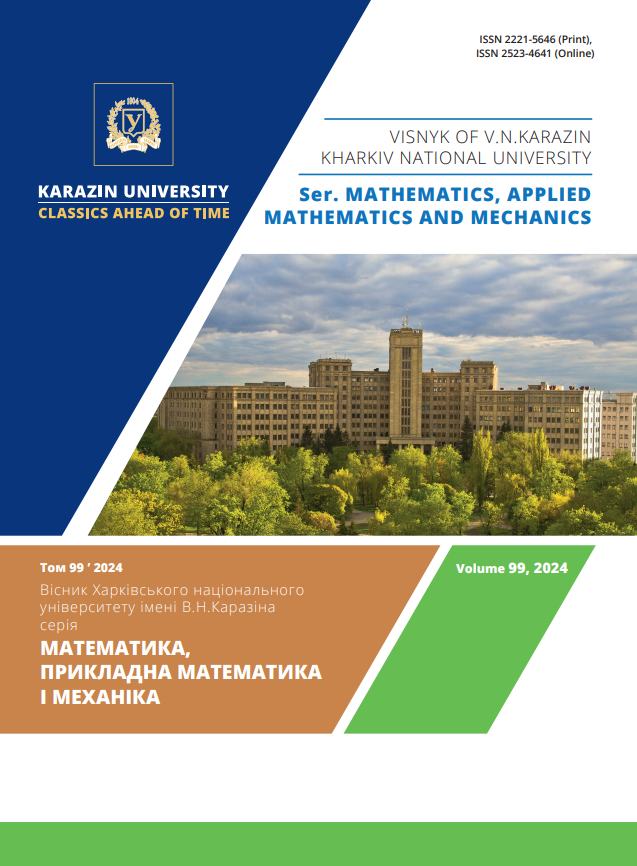The behavior of the generalized solution of the initial-boundary value problem for the nonlinear parabolic equation
Abstract
Within the framework of this work, we study the behavior of the generalized solution (or the so-called energy solution) of an interesting initial-boundary value problem (namely, the Cauchy-Dirichlet problem is considered) for nonlinear parabolic equation. The research is carried out in a cylindrical area. A structural condition is imposed on the parameters of the equation corresponding to the slow diffusion process. So, in the article we are dealing with the distribution of the substance concentration in space and time, taking into account the initial and boundary conditions. This process has a practical aspect and is used in physics and engineering, for example, to study the diffusion of matter in environments with variable concentration or chemical influence. Solving such problems allows obtaining important data on the evolution of the system and predicting its behavior in various conditions. In the work, as a result of our research, several integral ratios, various estimates and inequalities were established, which lead to the need to analyze the behavior of the differential system, which in turn makes it possible to establish the presence of the solution localization property. So, relying on the well-known results regarding the behavior of the solution of the resulting differential system, it is possible to find a condition that guarantees the localization of the solution carrier for the Cauchy-Dirichlet problem under study. The main result of the work is a theorem that is proved for an arbitrary finite initial function and under the condition of fulfilling a certain restriction on the limit mode. The article has a fairly standard structure and, in addition to annotations and literature, contains the following structural elements: introduction; Formulation of the problem; basic definitions; formulation of the main result; auxiliary inequalities for proving the main result; auxiliary statements for proving the theorem; proving the main result; conclusions.Downloads
References
H. W. Alt, S. Luckhaus, Quasilinear elliptic-parabolic differential equations, Math. Z. - 1983. - Vol. 183, No 3. - P. 311-341. DOI: http://dx.doi.org/10.1007/BF01176474
Ph. Benilan, P. Wittbold, On mild and weak solutions of elliptic-parabolic problems, Adv. Differential Equations. -1996. - Vol. 1, No 6. - P. 1053-1073. DOI: http://dx.doi.org/10.57262/ade/1366895244
J. I. Diaz, L. Veron, Local vanishing properties of solutions of elliptic and parabolic quasilinear equations, Trans. Amer. Math. Soc. -1985.- Vol. 290, No 2. - P. 787-814. DOI: http://dx.doi.org//10.2307/2000315
G. H. Hardy, J.E. Littlewood, G. Polya, Inequalities. Cambridge University Press. - 1952. - P. 324.
H. Poincare, Sur les Equations aux Derivees Partielles de la Physique Mathematique, American Journal of Mathematics. - 1890. - Vol. 12, No. 3 - P. 211-294. DOI: http://dx.doi.org/10.2307/2369620
K. Rektorys, The Friedrichs Inequality. The Poincare inequality. Variational Methods in Mathematics, Science and Engineering (2nd ed.). Dordrecht: Reidel.- 1977. - P. 188-198. DOI: http://dx.doi.org/10.1007/978-94-011-6450-4
E. Gagliardo, Ulteriori proprieta di alcune classi di funzioni in the most variabili. Ricerche Mat. - 1959. - Vol. 8. - P. 24-51.
A. E. Shishkov, A. G. Shchelkov, Blow-up boundary regimes for general quasilinear parabolic equations in multidimensional domains, Sb. Math. - 1999. - V. 190, No 3. - P. 447-479. DOI: http://dx.doi.org/10.1070/sm1999v190n03abeh000398
B. H. Gilding, M. A. Herrero, Localization and blow-up of thermal waves in nonlinear heat conduction, Math. Ann. - 1988. - Vol. 282.- P. 223-242. DOI: http://dx.doi.org/10.1007/BF01456972
C. Cortazar, M. Elgueta, Localization and boundedness of the solutions of the Neumann problem for a filtration equation, Nonlinear Anal. - 1989. - Vol. 13, No 1. - P. 33-41.
Copyright (c) 2024 Дарина Шевчук, Катерина Стєпанова

This work is licensed under a Creative Commons Attribution-NonCommercial-NoDerivatives 4.0 International License.
The copyright holder is the author.
Authors who publish with this journal agree to the following terms:
1. Authors retain copyright and grant the journal right of first publication with the work simultaneously licensed under a Creative Commons Attribution License that allows others to share the work with an acknowledgement of the work's authorship and initial publication in this journal. (Attribution-Noncommercial-No Derivative Works licence).
2. Authors are able to enter into separate, additional contractual arrangements for the non-exclusive distribution of the journal's published version of the work (e.g., post it to an institutional repository or publish it in a book), with an acknowledgement of its initial publication in this journal.
3. Authors are permitted and encouraged to post their work online (e.g., in institutional repositories or on their website) prior to and during the submission process, as it can lead to productive exchanges, as well as earlier and greater citation of published work (see The Effect of Open Access).




